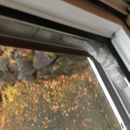Window Spacer Replacements
We bought a 20 year old energy efficient Canadian modular in Zone 6. Many bits need replacing soon – oil boiler, propane fireplace, water heater – which is a whole other topic. Meanwhile, 10 windows have this going on – squiggle (or swiggle?) failure. Local glass people will do aluminum spacers. Have read they conduct cold so should I be looking for something else?
GBA Detail Library
A collection of one thousand construction details organized by climate and house part











Replies
Ms. Remington,
The squiggle things you are observing are almost identical to what I see in some failed windows I am having replaced for my daughter. The glass company says they are an older style dessicant material that has swollen due to seal failure. Think of the little dry sponge toys that grow into animal shapes when put in water.
The windows that failed were original to the circa 2004 house, so it may be the same material you are seeing. The metal channels in my case are pretty clearly steel, as there is rust on some of the interior channel edges. The replacements I have ordered will have spacer bars made with the commonly seen aluminum material with little perforations along the strip.
It may have been possible to order replacement glass with super spacer material, which avoids metal to reduce thermal transfer at the edges. I chose not to go that way as the majority of windows in the house will remain the original type. The energy savings would be trivial overall, and indeed per room, as only one pane in the double-hungs failed.
If the 10 windows represent a major part of your glazing then you might consider asking about the better seal material. I think the aluminum spacers will still be a bit better than what you currently have, but the real improvement will likely be in the coatings for the glass. If the windows are 20 years old, rejuvenating the seals at the same time will also be a good idea.
Thank you - better than what I currently have seems like a step in the right direction. The way they look right now does give an impression of "held together with chewing gum".
Swiggle is a first generation warm-edge spacer, warm-edge meaning when swiggle was introduced "warmer than aluminum", but not by a lot. Material failure with swiggle is a when it's going to happen and not an if it's going to happen.
Aluminum is a tried-and-true solution for an IG spacer material and is still reasonably common with some manufacturers, especially smaller regional or local mom-and-pop glass shop operations that build their own replacement IG units rather than outsourcing from an actual manufacturer. Using an aluminum spacer is going to result in colder edge-of-glass and a significantly increased probability of glass-edge condensation versus a better quality warm edge spacer when the weather turns colder.
Do the local guys offer any other options to aluminum? Given the choice I would use aluminum over swiggle, not because it's a good choice but because it's just better than the alternative.
Greg,
I am curious if you know the trade/brand name of the warm spacer you are referencing. I guide my kids house maintenance when I can and this window failure is new to me.
I am quite sure the "squiggle" in my windows is a foam like material that was pressed into the metal channel creating the spacer between the two glass sheets. The notion of it being a dessicant material came from the window company doing the replacements.
I have re-examined the other windows without squiggles and I see the dessicant strip is often only applied to one channel strip or at best intermittently around the frame. When not over saturated by a window leak, the material lies snugly in the channel looking a bit like poured in putty.
The second picture provided by Ms. Remington shows a large gap in the squiggle material and seemingly the metal channel between the panes. Based on that photo, I felt it looked like the failure I was experiencing.
I replied to the original post on my phone, so I didn't take a good look at the pictures prior to replying. I saw swiggle in the original post and replied to that. The information on Swiggle still holds, but after looking at the pictures on my computer....the IG units in the pictures use an Intercept spacer not Swiggle.
Roger Berry, The Swiggle (not squiggle) spacer was originally developed by a company called Truseal, but Truseal sold their spacer systems (Swiggle, DuraSeal, and Duralite) to Quanex some years ago. Duraseal is pretty much just a rebranded Swiggle with a few upgrades, while Duralite is the newest version and it has the warmest edge among the most commonly used spacer systems.
Intercept was originally introduced by PPG, also one of the earliest warm-edge spacers. The Intercept comes in two versions, tin-plated steel and stainless. The stainless is a much better version but it's also very expensive when compared to the original tin-plated so isn't widely used in comparison.
The standard Intercept is probably the most widely used spacer for residential windows.
Can you post pictures of your spacers? From the description I am thinking that you also have Intercept and it sounds like they are in very poor shape.